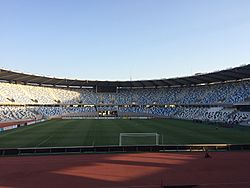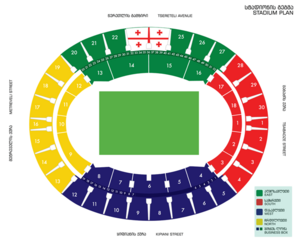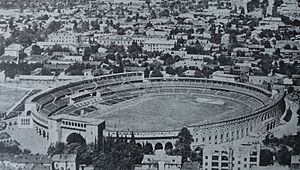Boris Paichadze Dinamo Arena facts for kids
|
Dinamo Arena
|
|

|
|
| Former names | Lenin Dinamo Stadium (1976–1990) Boris Paitchadze National Stadium (1995–2011) |
|---|---|
| Location | Tbilisi, Georgia |
| Coordinates | 41°43′23″N 44°47′23″E / 41.72306°N 44.78972°E |
| Owner | Dinamo Tbilisi |
| Executive suites | 52 |
| Capacity | 54,202 |
| Record attendance | 110,000 (Dinamo Tbilisi - Liverpool 3-0, 3 October 1979, Georgia-Germany 0-2, 29 March 1995) |
| Field size | 105 m × 68 m (344 ft × 223 ft) |
| Surface | Natural Grass |
| Scoreboard | Yes |
| Construction | |
| Built | 1976 |
| Renovated | 2006 |
| Architect | Archil Kurdiani, Gia Kurdiani |
| Structural engineer | Shalva Gazashvili |
| Tenants | |
| FC Dinamo Tbilisi (1976–present) Georgia national football team (1990–present) Georgia national rugby union team (selected matches) |
|
The Boris Paitchadze Dinamo Arena (Georgian: ბორის პაიჭაძის ეროვნული სტადიონი) is a famous stadium in Tbilisi, Georgia. It's the home field for Dinamo Tbilisi, Georgia's national football team, and sometimes the national rugby team.
With space for 54,202 fans, it is the biggest stadium in Georgia. It was built in 1976 by Georgian architect Gia Kurdiani. The stadium was first named after a Russian leader, but in 1995, it was renamed to honor Boris Paichadze, a famous Georgian football player. Before this stadium, Dinamo Tbilisi played at the Central Stadium, which held about 35,000 people. As Dinamo Tbilisi became more successful in the 1970s, they needed a much larger stadium. After it opened, it was the third-largest stadium in the Soviet Union.
Exciting Matches and Big Crowds
The first official game at the new stadium was on September 29, 1976. Dinamo Tbilisi played against Welsh team Cardiff City and won 3–0.
The stadium saw many great moments when Dinamo Tbilisi won big in 1978 and 1979. In 1981, 80,000 fans came with lighted torches to celebrate Dinamo Tbilisi winning the 1980–81 European Cup Winners' Cup.
The Dinamo Arena is now one of the largest stadiums in Eastern Europe. Most of the seats in the upper level are covered by a roof. The USSR national football team played several international games here. Other big teams like Spartak Moscow and Dynamo Kiev also played their autumn international matches at the stadium.
Record-Breaking Attendance
A huge crowd of 100,000 fans came to the first game of the Georgian Championship. This match was between FC Dinamo Tbilisi and FC Kolkheti-1913 Poti. The biggest crowd ever was in 1979, when 110,000 people watched Dinamo beat Liverpool F.C. 3-0. This win helped Dinamo reach the quarter-finals of the European Champion Clubs' Cup. Another 110,000 fans also attended a Georgia-Germany match in 1995. In the Soviet Union, this stadium had the highest average number of fans at games, around 65,000 per match.
In 1995, the stadium was renamed the Boris Paichadze National Stadium. It has been the home ground for the Georgian National Football Team for many years. Georgia has had memorable wins here, including beating Wales 5-0 and Poland 3-0.
The stadium was updated in 2006 and became an all-seater stadium. This means every fan has a seat. This change reduced the stadium's capacity to 54,549.
On August 11, 2015, the stadium hosted the UEFA Super Cup match. This was a big game between FC Barcelona and Sevilla FC.
Stadium History
The first "Dinamo" stadium, which could hold 23,000 fans, opened in Tbilisi in 1936. The design was by architect Archil Kurdiani.
In 1956, the stadium was rebuilt under his guidance. Steel structures were added, which increased its capacity to 36,000 spectators.
The much larger Dinamo Arena stadium opened on September 26, 1976. Architects Archil Kurdiani and Gia Kurdiani, along with designer Shalva Gazashvili, expanded the stadium to hold 74,354 people. Parts of the 1936 stadium were kept, but many new and complex design elements were added.
The stadium was built with a special design to make sure every fan had a good view. The roof was also used to hold lights and sound systems. The stadium had two electronic scoreboards. There were special boxes for important guests and commentary studios. Below the stands, there were sports facilities and offices.
The stadium's former swimming pool now houses a nightclub.
See also
 In Spanish: Estadio Borís Paichadze para niños
In Spanish: Estadio Borís Paichadze para niños
- Mikheil Meskhi Stadium
- List of football stadiums in Georgia
- List of rugby union stadiums by capacity
- Lists of stadiums



